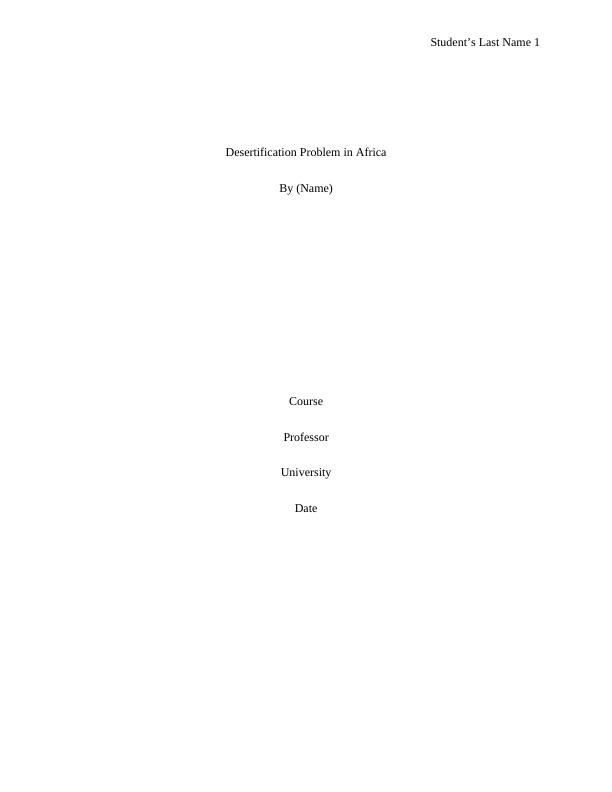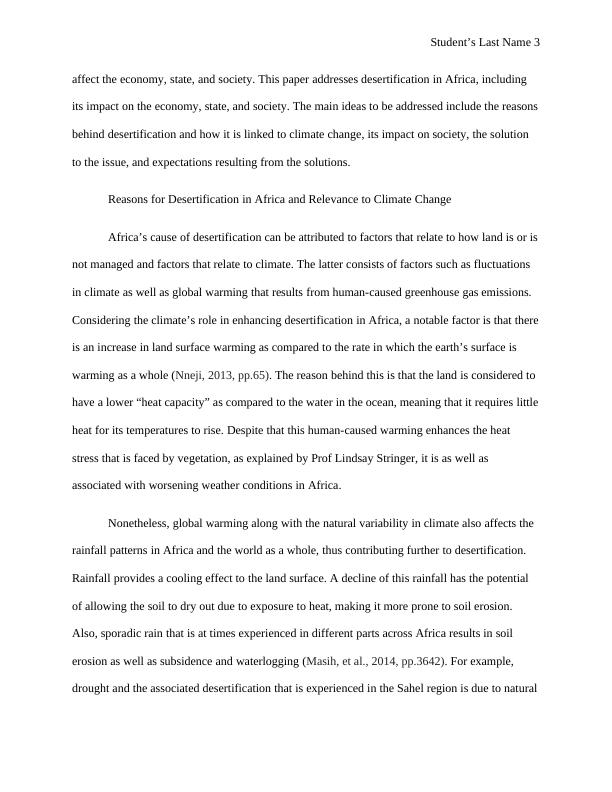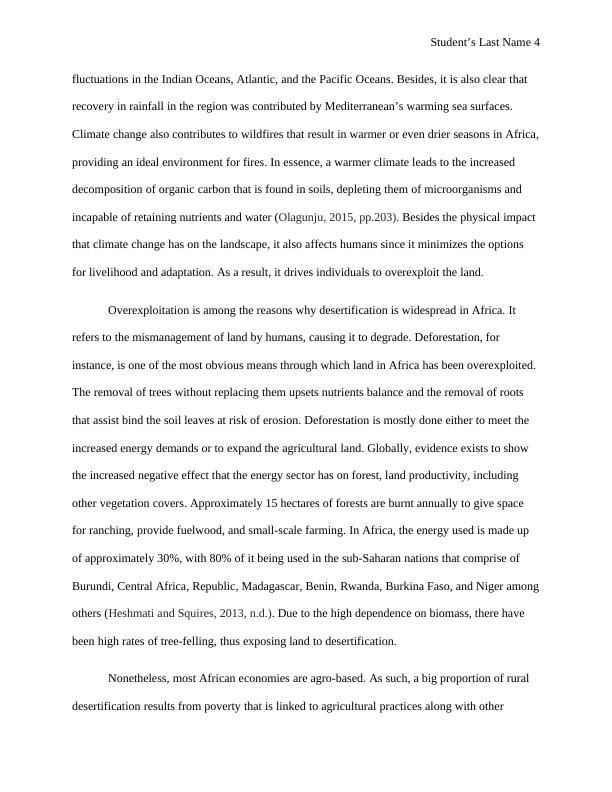Desertification Problem in Africa Research Paper 2022
16 Pages4478 Words71 Views
Added on 2022-09-29
Desertification Problem in Africa Research Paper 2022
Added on 2022-09-29
ShareRelated Documents
Student’s Last Name 1
Desertification Problem in Africa
By (Name)
Course
Professor
University
Date
Desertification Problem in Africa
By (Name)
Course
Professor
University
Date

Student’s Last Name 2
Introduction
There is a consensus that both at the global, regional, as well as the national political
agenda, the issues of Desertification, Land Degradation, and Drought (DLDD) are insufficiently
addressed. Hence, it is essential to raise awareness on these matters, not only basing the
arguments on DLDD’s negative effects in regards to the socio-economic but as well on the
opportunities that they are likely to create in guiding current land management practices to
ensure that they are more resilient and sustainable. Understanding the economic along with the
social costs as well as benefits associated with DLDD is important if the governments are to
develop cost-effective laws and strategies to address the issues, including raising awareness.
Specifically, desertification in Africa is a big problem that is affecting the economy, state, and
society. Desertification is considered among the main challenges that are hindering Africa’s
sustainable development. The issue has a far-reaching unfavorable effect on food security,
physical infrastructure, human health, natural resources and the environment, economic activity,
including national as well as national security.
Desertification refers to the permanent decline in dryland areas’ biological productivity.
It is estimated that 250 million individuals in over 100 countries globally are affected by
desertification. However, the issue is more prevalent in Africa, in which case, approximately
66% of the total land is either semi-arid or arid. In Africa, the causes of desertification are both
natural and man-made. Despite being sensitive to human activities, already dry lands result from
drought, climate change, increasing global temperatures, along with unpredictable rain patterns.
Some of the human-induced reasons that contribute to desertification include agricultural
technologies, population growth, and unsustainable policies. Due to these factors, the land is
degraded, creating effects that translate to the loss in biodiversity, including other outcomes that
Introduction
There is a consensus that both at the global, regional, as well as the national political
agenda, the issues of Desertification, Land Degradation, and Drought (DLDD) are insufficiently
addressed. Hence, it is essential to raise awareness on these matters, not only basing the
arguments on DLDD’s negative effects in regards to the socio-economic but as well on the
opportunities that they are likely to create in guiding current land management practices to
ensure that they are more resilient and sustainable. Understanding the economic along with the
social costs as well as benefits associated with DLDD is important if the governments are to
develop cost-effective laws and strategies to address the issues, including raising awareness.
Specifically, desertification in Africa is a big problem that is affecting the economy, state, and
society. Desertification is considered among the main challenges that are hindering Africa’s
sustainable development. The issue has a far-reaching unfavorable effect on food security,
physical infrastructure, human health, natural resources and the environment, economic activity,
including national as well as national security.
Desertification refers to the permanent decline in dryland areas’ biological productivity.
It is estimated that 250 million individuals in over 100 countries globally are affected by
desertification. However, the issue is more prevalent in Africa, in which case, approximately
66% of the total land is either semi-arid or arid. In Africa, the causes of desertification are both
natural and man-made. Despite being sensitive to human activities, already dry lands result from
drought, climate change, increasing global temperatures, along with unpredictable rain patterns.
Some of the human-induced reasons that contribute to desertification include agricultural
technologies, population growth, and unsustainable policies. Due to these factors, the land is
degraded, creating effects that translate to the loss in biodiversity, including other outcomes that

Student’s Last Name 3
affect the economy, state, and society. This paper addresses desertification in Africa, including
its impact on the economy, state, and society. The main ideas to be addressed include the reasons
behind desertification and how it is linked to climate change, its impact on society, the solution
to the issue, and expectations resulting from the solutions.
Reasons for Desertification in Africa and Relevance to Climate Change
Africa’s cause of desertification can be attributed to factors that relate to how land is or is
not managed and factors that relate to climate. The latter consists of factors such as fluctuations
in climate as well as global warming that results from human-caused greenhouse gas emissions.
Considering the climate’s role in enhancing desertification in Africa, a notable factor is that there
is an increase in land surface warming as compared to the rate in which the earth’s surface is
warming as a whole (Nneji, 2013, pp.65). The reason behind this is that the land is considered to
have a lower “heat capacity” as compared to the water in the ocean, meaning that it requires little
heat for its temperatures to rise. Despite that this human-caused warming enhances the heat
stress that is faced by vegetation, as explained by Prof Lindsay Stringer, it is as well as
associated with worsening weather conditions in Africa.
Nonetheless, global warming along with the natural variability in climate also affects the
rainfall patterns in Africa and the world as a whole, thus contributing further to desertification.
Rainfall provides a cooling effect to the land surface. A decline of this rainfall has the potential
of allowing the soil to dry out due to exposure to heat, making it more prone to soil erosion.
Also, sporadic rain that is at times experienced in different parts across Africa results in soil
erosion as well as subsidence and waterlogging (Masih, et al., 2014, pp.3642). For example,
drought and the associated desertification that is experienced in the Sahel region is due to natural
affect the economy, state, and society. This paper addresses desertification in Africa, including
its impact on the economy, state, and society. The main ideas to be addressed include the reasons
behind desertification and how it is linked to climate change, its impact on society, the solution
to the issue, and expectations resulting from the solutions.
Reasons for Desertification in Africa and Relevance to Climate Change
Africa’s cause of desertification can be attributed to factors that relate to how land is or is
not managed and factors that relate to climate. The latter consists of factors such as fluctuations
in climate as well as global warming that results from human-caused greenhouse gas emissions.
Considering the climate’s role in enhancing desertification in Africa, a notable factor is that there
is an increase in land surface warming as compared to the rate in which the earth’s surface is
warming as a whole (Nneji, 2013, pp.65). The reason behind this is that the land is considered to
have a lower “heat capacity” as compared to the water in the ocean, meaning that it requires little
heat for its temperatures to rise. Despite that this human-caused warming enhances the heat
stress that is faced by vegetation, as explained by Prof Lindsay Stringer, it is as well as
associated with worsening weather conditions in Africa.
Nonetheless, global warming along with the natural variability in climate also affects the
rainfall patterns in Africa and the world as a whole, thus contributing further to desertification.
Rainfall provides a cooling effect to the land surface. A decline of this rainfall has the potential
of allowing the soil to dry out due to exposure to heat, making it more prone to soil erosion.
Also, sporadic rain that is at times experienced in different parts across Africa results in soil
erosion as well as subsidence and waterlogging (Masih, et al., 2014, pp.3642). For example,
drought and the associated desertification that is experienced in the Sahel region is due to natural

Student’s Last Name 4
fluctuations in the Indian Oceans, Atlantic, and the Pacific Oceans. Besides, it is also clear that
recovery in rainfall in the region was contributed by Mediterranean’s warming sea surfaces.
Climate change also contributes to wildfires that result in warmer or even drier seasons in Africa,
providing an ideal environment for fires. In essence, a warmer climate leads to the increased
decomposition of organic carbon that is found in soils, depleting them of microorganisms and
incapable of retaining nutrients and water (Olagunju, 2015, pp.203). Besides the physical impact
that climate change has on the landscape, it also affects humans since it minimizes the options
for livelihood and adaptation. As a result, it drives individuals to overexploit the land.
Overexploitation is among the reasons why desertification is widespread in Africa. It
refers to the mismanagement of land by humans, causing it to degrade. Deforestation, for
instance, is one of the most obvious means through which land in Africa has been overexploited.
The removal of trees without replacing them upsets nutrients balance and the removal of roots
that assist bind the soil leaves at risk of erosion. Deforestation is mostly done either to meet the
increased energy demands or to expand the agricultural land. Globally, evidence exists to show
the increased negative effect that the energy sector has on forest, land productivity, including
other vegetation covers. Approximately 15 hectares of forests are burnt annually to give space
for ranching, provide fuelwood, and small-scale farming. In Africa, the energy used is made up
of approximately 30%, with 80% of it being used in the sub-Saharan nations that comprise of
Burundi, Central Africa, Republic, Madagascar, Benin, Rwanda, Burkina Faso, and Niger among
others (Heshmati and Squires, 2013, n.d.). Due to the high dependence on biomass, there have
been high rates of tree-felling, thus exposing land to desertification.
Nonetheless, most African economies are agro-based. As such, a big proportion of rural
desertification results from poverty that is linked to agricultural practices along with other
fluctuations in the Indian Oceans, Atlantic, and the Pacific Oceans. Besides, it is also clear that
recovery in rainfall in the region was contributed by Mediterranean’s warming sea surfaces.
Climate change also contributes to wildfires that result in warmer or even drier seasons in Africa,
providing an ideal environment for fires. In essence, a warmer climate leads to the increased
decomposition of organic carbon that is found in soils, depleting them of microorganisms and
incapable of retaining nutrients and water (Olagunju, 2015, pp.203). Besides the physical impact
that climate change has on the landscape, it also affects humans since it minimizes the options
for livelihood and adaptation. As a result, it drives individuals to overexploit the land.
Overexploitation is among the reasons why desertification is widespread in Africa. It
refers to the mismanagement of land by humans, causing it to degrade. Deforestation, for
instance, is one of the most obvious means through which land in Africa has been overexploited.
The removal of trees without replacing them upsets nutrients balance and the removal of roots
that assist bind the soil leaves at risk of erosion. Deforestation is mostly done either to meet the
increased energy demands or to expand the agricultural land. Globally, evidence exists to show
the increased negative effect that the energy sector has on forest, land productivity, including
other vegetation covers. Approximately 15 hectares of forests are burnt annually to give space
for ranching, provide fuelwood, and small-scale farming. In Africa, the energy used is made up
of approximately 30%, with 80% of it being used in the sub-Saharan nations that comprise of
Burundi, Central Africa, Republic, Madagascar, Benin, Rwanda, Burkina Faso, and Niger among
others (Heshmati and Squires, 2013, n.d.). Due to the high dependence on biomass, there have
been high rates of tree-felling, thus exposing land to desertification.
Nonetheless, most African economies are agro-based. As such, a big proportion of rural
desertification results from poverty that is linked to agricultural practices along with other

End of preview
Want to access all the pages? Upload your documents or become a member.
Related Documents
Global Warming and Its Impact on Earth: A Comprehensive Analysislg...
|7
|2036
|493
Assignment on Global Climate Changelg...
|12
|3537
|15
Causes and Effects of Global Warminglg...
|5
|1650
|53
Building A Sustainable Organizationlg...
|6
|1252
|278
Climate Change: Result of Human Activities?lg...
|5
|2022
|88
Environmental Management and Sustainable Development Issue 2022lg...
|18
|4982
|38
